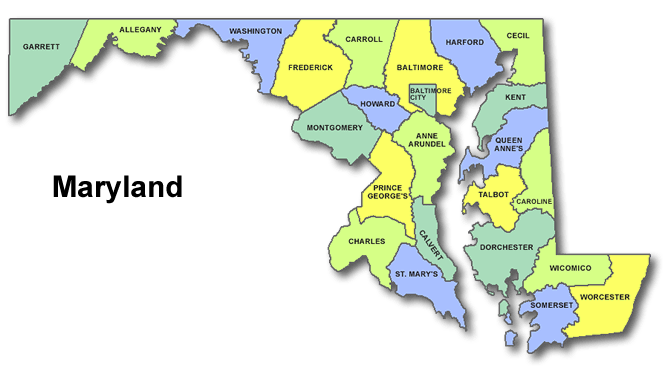Maryland is a small state in the eastern United States, one of the so-called Mid-Atlantic states and one of the 13 states that made the American Revolution. The capital is Annapolis (Maryland), the largest city is Baltimore.
STATE NAME
The state of Maryland was named after Henrietta Maria, daughter of King Henry IV of France and wife of King Charles I of England, Scotland and Ireland.
GEOGRAPHY
The state of Maryland is located in the South of the United States and belongs to the South Atlantic states. The territory of the state of Maryland is 32,133 km2 (rank 42 among US states). Maryland is bordered by Pennsylvania to the north, Delaware to the east, Virginia and the District of Columbia to the south, and West Virginia to the south and west. In the southeast, the shores of Maryland are washed by the waters of the Atlantic Ocean. Maryland is part of the US Eastern Time Zone. Although Maryland is small in area, its natural conditions are very diverse (it is no coincidence that one of its nicknames is “America in miniature”). There are three main physiographic regions in the state: the coastal lowlands in the east, the Piedmont Plateau in the central part, and the Appalachians in the west.
CLIMATE
Due to the features of the relief and depending on the distance from the ocean, different regions of Maryland vary greatly in climate. The eastern counties of the state experience a humid subtropical climate with hot, humid summers and short, mild winters. In Ocean City, located on the Atlantic coast of the Delmarva Peninsula, the coldest month, January, typically averages between -2°C and 7°C, while the hottest month, July, averages between 19°C and 29°C. In Maryland’s largest city, Baltimore, which is on the western shore of the Chesapeake Bay, January is typically -1°C to 7°C and July is 23°C to 33°C.
Further west, on the Piedmont Plateau, winters become somewhat cooler, with the city of Hagerstown averaging -6°C to 3°C in January and 18°C to 30°C in July. Further west, in the Appalachians, the climate is subtropical mountainous and even humid continental, in the city of Cumberland the temperature in January ranges from -7°C to 4°C, and in July from 17°C to 31°C.
Economics
Maryland ranks first among US states in terms of median income per family, and two Maryland counties are among the ten richest counties in the country. To a large extent, the welfare of the state is due to the proximity of the capital of the United States of America – Washington, but in addition, services, medicine, education, research and development, and, to a lesser extent, industry and agriculture are well developed in Maryland. There are practically no minerals in the state (only relatively insignificant amounts of coal mining in the western districts), but thanks to its advantageous geographical location, Maryland is an important transport hub for the United States, and the port of Baltimore is one of the largest on the east coast of America.
TOURISM
The small state of Maryland (Maryland, 32.1 thousand sq. Km) is widely known for the diversity of its nature. Sand dune areas in the east are adjacent to numerous marshes, and the oak forested hills of the central regions smoothly turn into foothill pine forests, while almost a quarter of the state is occupied by various reservoirs (mostly artificial). People come here to relax on the sandy beaches of Ocean City or the resorts of Deep Creek Lake, visit the sea restaurants of Fell’s Point and Canton, take a boat ride around the outskirts of Little Italy, Fell’s Point or Smith Island, visit the headquarters of Washington in the Chesapeake and Ohio-Chanell National Historical Park or at the Naval Academy (founded in 1845) of Annapolis, see the star-shaped Fort McHenry or the city of strange brick buildings and parks – Frederick.
Largest Counties in Maryland
Founded as a refuge for Catholics in 1634, Maryland was one of the original 13 colonies and played an important role in the Civil War as a border state. Maryland has 23 counties and 1 independent city (Baltimore). 10 Largest…
Read more


























